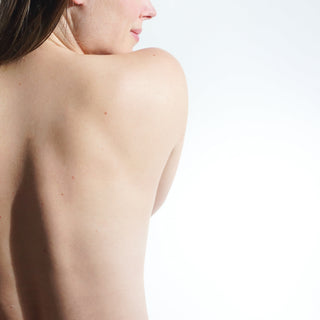(Psst…none of this is medical advice–just a word to the wise.)
Is your skin ready for winter?
While not everyone experiences a dramatic shift in their skin during the colder months of the year, it’s certainly not uncommon– especially if you have eczema.
If you find yourself bracing for the seasonal flare to strike, you're not alone. The colder temperatures, dryer air, and indoor heating can all trigger this sometimes unbearable inflammatory reaction. Even the dust from pulling your holiday decorations out of storage can bring on the itch.
And though it may feel like steroid creams are the only thing that can get you through, suppressing your symptoms could lead to even more issues down the road. I promise there are much better options that don’t come with harmful side effects or weaken your skin further.
The real secret to healing eczema for good (even in the wintertime) is to shift your focus from symptom management to trigger prevention and foundational nourishment. Keep reading to discover what’s really inflaming your skin and how to support it inside and out. Grab some coffee or electrolytes, this is a deep dive.
What is eczema? How it differs from psoriasis.
Eczema is actually an umbrella term for a family of 7 different immune-reactive skin conditions, the most common being atopic dermatitis. This form of eczema causes red, inflamed, dry, extremely itchy skin in people of all ages, but particularly in children. (1)
It can crop up all over and is most common in areas where the body bends (backs of the knees, elbows, and neck).
Eczema is similar to psoriasis in the way that it involves the immune system, though instead of accelerating skin cell multiplication, it breaks down the moisture barrier. (2) This mechanism leaves the skin significantly more prone to losing water and vulnerable to irritants– both drivers of dryness and inflammation.
What’s at the root of eczema flares?
It’s clear that suppressing flares with steroid creams ignores what’s really going on, which is why it’s important to determine what’s making the skin so susceptible in the first place.
Could it just be genetics? Weather changes?
While your genes make you more prone to flares, and the dry air can certainly be a trigger, none of these are likely the underlying cause of eczema.
And, like with all health conditions, there’s no cut-and-dry answer here. But there are 5 main drivers of eczema to keep in mind while embarking on your healing journey. You’ll notice a lot of these are intertwined and have a direct or inverse relationship.
1. The allergenic pathway
About 30% of adults and 40% of children with eczema also have a food allergy. Cutting out the specific foods you’re allergic to doesn’t always have an effect on the course of your eczema, but many people have reported positive results from modifying their diet to avoid such foods. This makes a lot of sense if you think about how eating exacerbating foods may be adding to the total systemic inflammation in your system (including your skin). A very common trigger food is gluten, but you can find out what specific foods you may be allergic to by taking a food sensitivity test. (3)
The other common theme in the research is that roughly 20% of adults with eczema also have asthma. (4) This is why it’s also important to consider possible environmental allergens such as dust, mold, or even natural wool. Using suppressive topical treatments without changing the environment can actually lead to an inward progression that eventually affects the lungs. It can be a good idea to start using an air purifier in your home during the winter months when you aren’t opening the windows as much to address airborne triggers. But no one case is the same, so self-experimentation is key, and working with a homeopath can help address more complex cases.
2. A compromised gut
You need to be pooping– a lot. The optimal frequency range is somewhere between twice a day to 4 times a day. Any less might indicate a slow transit time and “lingering foods,” which can contribute to the body’s toxic load and increase overall inflammation (i.e. eczema). Combine this with a weakened intestinal barrier, and you have a perfect storm for skin issues.
You can improve your transit time by including more:
- healthy fiber from in-season fruits and well-cooked root veggies
- nutrient-dense fluids like bone broth, raw milk (if tolerated), and fruit juices
- foods that support the gallbladder (beets, dandelion, ginger, milk thistle)
Studies also reveal that oregano oil can be helpful in modulating gut bacteria and promoting intestinal barrier integrity. (5)
3. Histamine reaction
This is a big one, and it can be super confusing. Histamines are immune signaling proteins released by mast cells in response to an allergen or toxin. They’re what allergies are made of, and they’re known to exacerbate gut symptoms even further. It’s why people resort to steroid creams to suppress eczema symptoms short term. Though, in and of themselves, histamines aren’t the problem– we actually need them to stay healthy.
Things get out of hand when they overreact. This happens when the body is out of balance due to trauma, hormone imbalance (specifically with progesterone), genetic mutation, parasites, mold exposure, or nutrient deficiencies. These situations can deplete the body of the nutrients (magnesium, copper, and B6) that make up the enzymes required to properly break down histamine (DAO and HNMT). So, the key to regulating the histamine response is bringing the body back into balance through foundational support with plenty of sleep, sun exposure, stress management, blood sugar regulation, and targeted supplementation.
The tricky part is that many people with high histamine, or histamine sensitivity, have a low tolerance for some of the most nutrient-dense foods like liver, oysters, milk, and orange juice. So it’s a good idea to start building back the nutrients specifically needed to handle histamine, like magnesium (even if it's just topical), copper, and B vitamins. The Holistic Mother on Instagram has a lot of amazing resources for those dealing with histamine issues.
4. The estrogen connection
Sometimes, histamine intolerance isn’t the root cause, but rather, it’s an overload of estrogen. This is true, especially for women, as estrogen stimulates the release of histamine and even downregulates the DOA enzyme that clears histamine. It's a double whammy. And on top of that, histamine stimulates the ovaries to make even more estrogen– so the vicious cycle continues. (6)
The key here is to encourage the healthy clearance of estrogen by:
- avoiding xenoestrogens in plastics, conventional skincare (gross), makeup, cleaning products, artificial fragrances (ew), and pesticides.
- support phase 1 detoxification in the liver, which calls for an abundance of B vitamins, fat-soluble vitamins, minerals, and vitamin C.
- support phase 2 detoxification in the liver, which calls for amino acids like glycine, taurine, glutamine, and cysteine found in animal products like meat, fish, and dairy.
- ensure estrogen doesn’t get reabsorbed in the gut by incorporating binding fibers like raw carrots, cooked mushrooms, bamboo shoots, papaya, and cooked greens.
- support healthy progesterone production by lowering overall stress and balancing blood sugar with enough protein, carb, and fat at every meal.
5. Nutrient deficiency
As you may have noticed, all of the other potential causes of eczema link back to nutrient deficiencies. It’s really quite simple– if the body is depleted, problems arise. Getting a grip on where your body is specifically falling short can be extremely helpful through lab testing. But truly, getting back to basics is a great place to start by focusing on nutrient-dense ancestral foods where you can.
A deficiency that often accompanies eczema is that of vitamin D. This should come as no surprise considering the vital role vitamin D plays in both skin barrier function and immune response. (7) Of course, the best way to up your levels of this crucial nutrient is by letting the cholesterol in your skin convert ultraviolet rays from the sun into bioavailable hormone D. A process that is disrupted by sunscreen and impossible without magnesium. One of the many reasons why unobstructed sunlight is pivotal to your health.
Unfortunately, we are entering the darkest season of the year, which obviously makes synthesizing vitamin D in-house much more challenging. This is where incorporating more D-rich foods (beef liver, salmon, cod liver oil, sardines, and dairy products) and targeted supplementation can come in handy.
Always subtract triggers first.
In the case of eczema, it really is more about taking triggers out than adding new treatments in.
What to subtract:
- environmental triggers (mold, dust, dry air, pet fur, pollen)
- potential trigger foods (could include gluten, salicylates, nightshades, egg whites, some dairy)
- harsh soaps and cleansers (these strip natural moisture and further compromise barrier function)
- petroleum and mineral oil (increases oxidative stress and inflammation long term)
- water contaminants (cleansing the skin in hard water can irritate and disrupt pH balance)
- fragrances and essential oils (opt for fragrance-free skincare to stay safe)
Wintertime environmental support for eczema.
This time of year is particularly challenging for eczema-prone skin. But there are many things you can do to eliminate triggers and minimize irritants.
Here are some of our favorite environmental strategies to protect your skin:
- Run a HEPA air purifier in your home– this will keep airborne allergens to a minimum.
- Install a shower filter– to reduce hard minerals and contaminants (helps hair, too!)
- a humidifier in your bedroom– adding moisture back to the air can help keep skin hydrated and less likely to flare.
- Damp dust only– instead of recirculating dust in your home with dry dusting, a damp microfiber cloth traps the dust, making it easier to clean safely.
- Take shorter, milder showers– though long, steamy showers are tempting, the hot temps damage the skin barrier, leading to more inflammation and dryness.
- Wear non-irritating fibers like cotton, silk, and cashmere– layering in synthetic fabrics, and even some natural fibers like wool, is a common eczema trigger.
- Burn unscented beeswax candles– toss your endocrine-disrupting and eczema-flaring scented holiday candles, it’s not worth it. Natural beeswax won’t trigger flares and can help purify the air.
Can red light therapy help with eczema?
Absolutely!
Red light therapy is an incredible healing tool that can lower systemic inflammation and promote full-body recovery. It’s incredibly helpful in acute situations where you need temporary relief from itch and other symptoms, but it also supports the body on a cellular level to promote long-term healing.
When therapeutic red light touches the skin, it activates photoreceptor proteins in your cells' mitochondria to produce more energy. This allows your cells to renew and repair damaged tissue much more efficiently, resulting in stronger, less eczema-prone skin. (learn more about red light therapy here)
Your skin is hungry– not thirsty.
The bottom line is that your skin needs real nutrition.
Relying on water-based lotions or symptom-suppressing steroid creams will not satisfy your skin. These nutrient-void products evaporate way too quickly and are loaded with irritants that further deplete your skin.
Eczema is a clear sign that the skin barrier is deficient in essential fatty acids. This is why a nutrient-dense, saturated fat like tallow is so helpful in rebuilding skin integrity and restoring moisture levels. The rich fatty acids soften and lubricate while naturally occurring vitamins and minerals repair and prevent water loss. It's food for skin.
And just as your body’s nutrient needs change throughout the year, so do the needs of your skin. Sometimes, you’ll require more– sometimes less.
This transition doesn’t have to trigger more eczema flares– simply tune in and adapt.
.
.
.
As always, while we hope to be a no-nonsense resource, we encourage you to do your own research to find the healthiest options for you and your family.
You can check out our collection of good-for-you, tallow skincare products by clicking the link below. We hope to see you there!
REFERENCES:
- “Eczema (Atopic Dermatitis) | NIH: National Institute of Allergy and Infectious Diseases.” Www.niaid.nih.gov, 19 Apr. 2017, www.niaid.nih.gov/diseases-conditions/eczema-atopic-dermatitis#:~:text=Eczema%2C%20or%20atopic%20dermatitis%2C%20is.
- Ballard, Angela. “Is It Eczema or Psoriasis?” National Eczema Association, 3 Sept. 2021, www.nationaleczema.org/blog/eczema-or-psoriasis/.
- Dhar S, Srinivas SM. Food Allergy in Atopic Dermatitis. Indian J Dermatol. 2016 Nov-Dec;61(6):645-648. doi: 10.4103/0019-5154.193673. PMID: 27904183; PMCID: PMC5122280.
- Yaneva, M., Darlenski, R. The link between atopic dermatitis and asthma- immunological imbalance and beyond. asthma res and pract 7, 16 (2021). https://doi.org/10.1186/s40733-021-00082-0
- Zou Y, Xiang Q, Wang J, Peng J, Wei H. Oregano Essential Oil Improves Intestinal Morphology and Expression of Tight Junction Proteins Associated with Modulation of Selected Intestinal Bacteria and Immune Status in a Pig Model. Biomed Res Int. 2016;2016:5436738. doi: 10.1155/2016/5436738. Epub 2016 May 29. PMID: 27314026; PMCID: PMC4903144.
- Briden, Lara. “How to Lower Estrogen.” Lara Briden - the Period Revolutionary, 2 May 2023, www.larabriden.com/the-ups-and-downs-of-estrogen-part-2-estrogen-excess/. Accessed 29 Nov. 2023.
- Mesquita Kde C, Igreja AC, Costa IM. Atopic dermatitis and vitamin D: facts and controversies. An Bras Dermatol. 2013 Nov-Dec;88(6):945-53. doi: 10.1590/abd1806-4841.20132660. PMID: 24474104; PMCID: PMC3900346.


